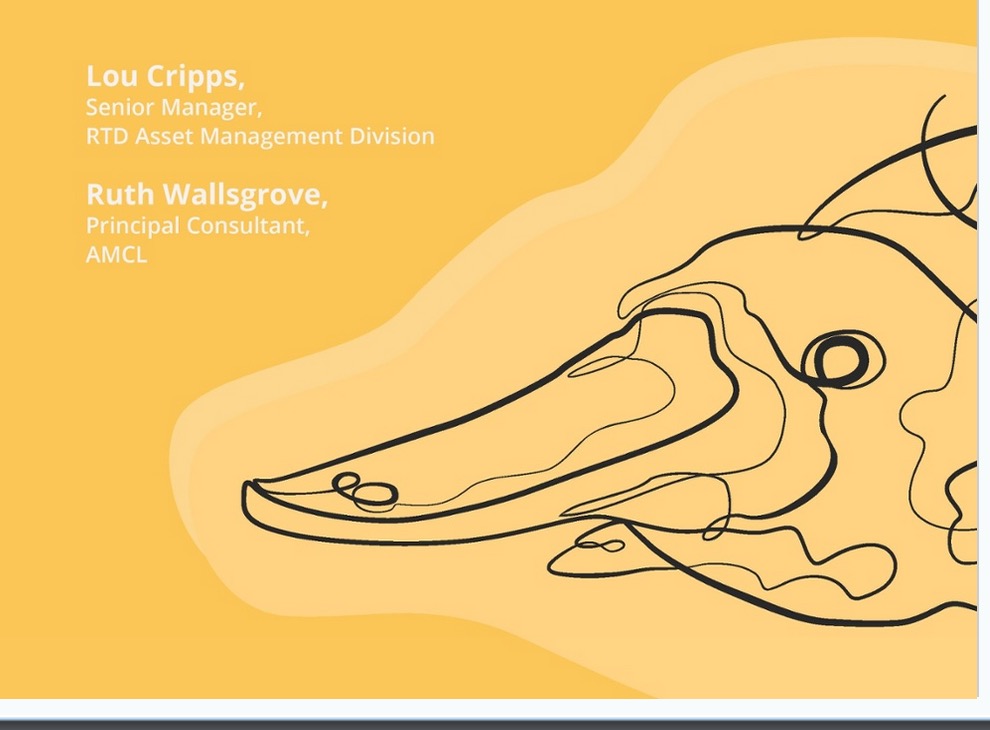
Why should we encourage diversity among Asset Managers? This is not just about access, equity and inclusive working environments – although there is a way to go, still, on that, even in our fairly young area.
As Janet Yellen, the USA Fed’s first female chair put it: “Beyond fairness, the lack of diversity harms the field because it wastes talent. It also skews the field’s viewpoint and diminishes its breadth.”
Asset Management is all about how people with different skills and perspectives work together to a better solution, about seeing wider than any of us can do as individuals.
What different perspective did you bring that made the difference?
I work in a group of fantastic North American Asset Management practitioners called Women in Asset Management NA, and this is the question we are tackling. We would love to hear from you.

Jos van Ouwerkerk, pexels.com
People like us who are responsible for managing public infrastructure assets always leave a legacy. Good or bad, that depends on how well we do our jobs now.
Famously politicians, along with billionaires, are attracted to the idea of a shiny new asset with their name on it. They see themselves remembered and honoured every time anyone drives down a road named for them. But this is often not true.
Firstly, if the road is poorly designed and badly maintained, no-one will be honouring your memory.
Secondly, if this puts the community into long-term debt, or wrecks other community benefits such as a stream or potential for other services – anything that will prevent them from doing what is needed in future: this is a poor legacy. Even if not everyone remembers it was your doing, they will not think kindly about whoever was responsible for such short-sightedness.
Thirdly, by definition, it is a poor public servant who puts their own ego against the needs of their community.
What would be a good legacy?
What would you like to leave for future generations?

We now have a Publications section. Our first highlighted publication is Building an Asset Management Team by t’s available for Kindle for just a few dollars, and you can read it on eReaders, phones and tablets.
Building an Asset Management Team is a practical and lively guide for anyone who needs to do infrastructure asset management. It tackles who you need and why you need them.
Asset Management is increasingly important, legally mandated in many countries. ISO 55000 defines AM as the ‘coordinated’ activities of an organization to realize value from its assets. But longer term co-ordinated asset plans and strategies take real effort and skills. You can’t just think things better.
To succeed, you require good business understanding, broad technical knowledge of the assets, analytical skills, and great facilitation & communication…. Instead of searching for a platypus, it’s easier to build a complementary team.
Invaluable if you are developing a business case for setting up an AM team, considering where to locate the team in your structure, or how to attract and keep the right staff.
Proceeds of the sales of this book go to Talking Infrastructure. We are a not- for-profit association and we do not charge for membership, so if you would like to support us – and support yourselves – please consider buying this book, and recommending it to your colleagues and asset management associations. Find 5 excerpts from this book by putting ‘AM Teams’ in the search bar.

“The farther back you can look, the farther forward you are likely to see” Winston Churchill
Until around 1996 the terms ‘Asset Management’ and ‘Strategic Asset Management’ were practically synonymous. But with the increasing popularity of the term ‘Asset Management’ to describe a wide variety of activities, as described in Pt 1, there was a need for a term that could differentiate decision making from the doing so, in January 1999, when the Asset Management Quarterly became fortnightly and thus needed a name change, I chose “Strategic Asset Management”, popularly known as SAM.
This was to stress that Asset Management wasn’t maintenance and reliability, or capital acquisition, or Treasury asset sales or many of the other associated activities, but rather what later became known (in ISO 55,000) as ‘the alignment of asset activities with the goals and objecitves of the organisation’
The first issue of SAM, January 1999, explained the name change, and in doing so, focused on what differentiates asset management from what went before.
“The real key to being strategic is where you focus your attention. If you focus on what you are doing you are carrying out an operational task; if you focus on how you are doing it, seeking to ‘tweak it’ or do it better, then you are engaged in a tactical activity. Both of these are necessary and important. However, they are not strategic. The strategic task is the one that focuses on the outcome, or the purpose….What constitutes a ‘better’ outcome, however, is not for the maintenance manager to decide. A ‘better’ outcome is one that moves the agency in the direction of its strategic vision.
By way of illustration, take the construction of a new hospital. If the questions you are asking yourself are ‘what is the purpose of this new hospital; what needs are we providing for, should we be providing them or should they be provided by others, or should they not be provided at all; is a new hospital required or are there better means?’, then you are focussing on the outcomes – ie being strategic.
Asking yourself ‘should this construction be carried out as a ‘design-construct’, ‘build-own-operate’ or some other form of contract’ is asking tactical questions. If you ask ‘how do I ensure this construction comes in within time and budget and is of the right quality’ then you are engaged in an operational task.
Thus ‘Strategic’ is not the same as ‘Important’. ALL aspects of asset management are important.”
In January 2014, the first international standard in asset management, ISO 55,000 was launched, and with this, we came to the end of the beginning of Asset Management. No longer a novelty, a new-comer; Asset management arrived.
For What Happened Next see: AM – The third wave

Photo by Marcus Spiske, from unsplash.com
‘I wish it need not have happened in my time,’ said Frodo.
‘So do I,’ said Gandalf, ‘and so do all who live to see such times. But that is not for them to decide. All we have to decide is what to do with the time that is given us.’*
What do envy and the attitudes of some people responsible for infrastructure at this time have in common?
Wishing things were different, instead of getting down and actively working to change things.
This was prompted by a conversation last week with an Asset Manager struggling to get their executive to stop moaning about how unlucky it all is, and start planning for what’s going to be needed going forward from Covid-19. People paid a goodly amount of money to take responsibility, who instead are acting like victims: everything would have been ok, if only….
Wanting the world on your own terms is not a strategy. Managing assets is for life, not just for Christmas, not just the good times.
It made me think again how vital the principle of honesty is for good infrastructure management. Chris Lloyd and Charles Johnson in their Seven Revelations of Asset Management (Assets, May 2014) put it like this: Asset Management demands openness about past performance. We have to face up to what’s gone on before, how well (or how badly) the assets are doing.
But we also have to honestly face up to change – even when it looks calamitous. That is what responsibility means.
Even discussing the deadly sins soon comes round to Asset Management!
The serious point is how we build up that sense of responsibility, in ourselves and in top management, to do our level best with what we have taken on. To commit to be better informed, better trained, to learn from best practice and to live it.
No-one forces anyone else to involve themselves in crucial infrastructure. You do not have to apply to be CEO of a public service, or run for election to the Council – but, having made that choice, it’s not a cushy number.
*J.R.R. Tolkien, The Fellowship of the Ring

In Australia, interest in asset management arose as the result of a series of eight parliamentary reports in South Australia in 1986/1987 modelling the likely cost and timing of renewing all the State’s major infrastructure assets.
The projected costs were so large that they would have absorbed the State’s total capital budget within the next 10 years if urgent action was not taken. To address this problem, the recommendations in the reports covered possible planning and accounting reforms as well as engineering and maintenance changes.
Following the Public Accounts Committee’s Reports, a major SA Government Task Force was established that reviewed, then agreed and reinforced all the ideas presented in the reports. This led to the formation of a Cabinet sub-committee to consider the issues raised, This provided high level impetus for the development of asset management.
Further support was provided by the Auditors-General who were appalled to find that no public sector department. not even the statutory authorities, had decent asset registers and they made this a requirement.
But the most significant change was that led by the Australian Accounting Standards Board. At this time the board covered accounting standards in both the private and the public sectors. The private sector used commercial standards with accrual accounting but the public sector used cash accounting. The board wanted to standardise on accrual accounting for both but was concerned about how this would be received. When it learnt that the Parliamentary Public Accounts Committee in South Australia was promoting the idea of accrual accounting to better understand and deal with infrastructure asset management, it was encouraged to push ahead. Within two years of the release of the final PAC report, the board had released Exposure Draft 50, the model of accrual accounting for local government.
The introduction of accrual accounting meant that local, state and federal government departments were required to move from their previous practice of simply recording annual cash in and cash out, to establishing balance sheets and recording, for the first time, the depreciated value of their infrastructure and other assets,
You might think that an accounting change would be of no interest to maintenance engineers. Fortunately @Roger Byrne was not your ordinary maintenance manager. He had already been in the habit of including economic and planning issues in briefing notes for his clients and he quickly seized on the opportunity this change presented for maintenance engineers.
It was these briefing notes that later provided the content for the first local government asset management manual which subsequently became the IIMM we all use today. So through top down interest and bottom up capacity building, Australia took an early lead in the development of asset management.
The Parliamentary Reports created a lot of interest Australia wide. No other state was prepared, or even able, to duplicate the research for their own constituency but all infrastructure agencies recognised that the conclusions reached applied as much to them as it did to their South Australian counterparts. The CSIRO’s Engineering and Construction division took an active interest, as did State Treasuries and the Auditors-General.
With these organisations, I continued to develop the ideas that had arisen and, after advising governments, commissions of audit, and infrastructure agencies themselves, I created ‘The Asset Management Quarterly’ publication in 1994 to share with others what I was learning. Then, in 1996, noting that lots of interesting things were being done in the name of asset management – but nothing was being documented, I launched the International Asset Management Competitions where the awards went to the best documentation of good asset management practice. They ran between 1996 and 2000 and in 1998 AMQ International launched the world’s first asset management website with information on asset management freely available to all.
The term ‘asset management’ started to become very popular and everyone wanted to get in on the act. One day, flying from Sydney to Canberra my seat companion described herself as an asset manager – on questioning it turned out that she was actually a real estate developer! Once off the plane and into a taxi, on the taxi radio I heard an advertisement for ‘asset management services’ – which turned out to be office cleaning! Yes, asset management had become the buzzword ‘de jour’.
To be continued….
A REQUEST
I am currently working on a book about our beginnings and would love to speak with anyone about their recollections pre 2014.
Please leave your name below and I will contact you.

I woke up with a start last week thinking: good Asset Management is all about time.
We tend to think of managing physical assets being about space – things, in systems and networks, on sites. But this is what we inherit from Engineering. Engineers manage space, things in space. But we do not train them to consider the fourth dimension: what these things in space will look like, or deliver, in ten, or fifty, or a hundred years’ time.
I mean, it is hard enough to design a functioning system: to think beyond individual assets or components, to how they all work together. Our engineering training is not always that successful in getting us to think in systems, and how the whole adds up to something other than all the pieces: to deliver the services our organisations and our communities require. We still have some way to go to this ‘alignment’ from assets to output, let alone outcome. And system interactions can be difficult, especially if they cross discipline and silo boundaries.
But, unfortunately, we have to go even beyond this.
Lou Cripps of RTD Denver describes a good Asset Management practitioner as a time traveller. Managing for the future, based on where we are now, and informed by historical experiences and data. With physical systems, we always have to start where we are now, to be grounded in the physical realities, not floating free in blue skies. And we need the historical experience to be able to project forward, through modelling in its widest sense.
The first engineering manager I worked for described smart engineers as wanting to make leaps unfettered by whatever mess we were currently in. “With one bound, he was free!’ (This also reminds me of some strategic planners I have met…)
A good Asset Manager, I suspect, may be no less ambitious, but focused on something else: the challenge of working from where we are now, whatever that may be, to a sustainable infrastructure future. Not pinning too much hope on magic to come that might change the basic physical realities, or people, but thinking how the next step could lead to the step after that, how one consequence can lead to another, thinking about time and through time.
What kind of tools do we need to assist us in this?
What kind of education do we need for our Asset Managers of the future?

Mama
It was 2016 and I was engaged to train Auditors-General in the Pacific area in how to approach infrastructure performance audits. Their audit offices, like their countries, were not well resourced and they could ill afford to waste time and resources. It was important that they focused on the key issues and got their messages across to decision makers. With my colleague, Kerry McGovern, I spent a week in Port Moresby. At the closing party I was honoured with the title ‘Mama’. I thought this was simply a recognition of my age, but no, “mama” meant a wise woman who leads a village. I was enchanted! Who would not want to be wise and lead a village? And is this not what councils do?
So when approached last week to help the UN who are preparing a manual to assist local governments in under-developed countries struggling to adopt AM, I was happy to oblige. I spoke with Kerry and we prepared out ‘top dozen’, as follows.
What needs to be added?
- Build with your own labour and your own local materials. This will ensure you have the skills and ability to maintain what you build.
- Learn to say ‘No’ when donors offer to build something for you with their labour, or to use imported materials when local alternatives are available. Always seek out alternative practices that use local. Welcome financial assistance if, and only if, it strengthens the ability of your own people in the construction, operation and maintenance of the new assets. That is necessary to ensure that the assets will remain functional.
- Prioritise. Do not accept ‘nice to have’ assets, such as sports stadia or entertainment centres, even as donations, if you have more critical requirements in power, water, roads or communications.
- There is no such thing as a ‘free asset’. Every asset costs you. Not only does it require continuous operational costs such as lighting/heating/cleaning, but it will distract the attention of high level decision makers away from other issues.
- ‘Best practice’ and ‘high tech’ can be deceptive. The real ‘best practice’ is the one that you have the skills and abilities to apply over the longer haul. The same for ‘high tech’. The more complicated the technology the more chances are that something will go wrong and that you will be unable to fix it without outside help. And that help may not be available when needed.
- Give your Auditors-General responsibility for auditing the performance of all public infrastructure for both effectiveness and efficiency – and fund and train them in the ability to do so.
- Be clear on what is to be achieved. Assist the Auditors-General by ensuring that all infrastructure proposals – whether with local or donated funds – state clearly the expected outcomes, in addition to cost and time.
- Identify who is going to operate the asset, who is going to maintain the asset – both scheduled maintenance, and unscheduled maintenance and the costs of enabling the operation and maintenance over the entire life of the asset. Then, with that estimate to hand (and preferably arrived at with input from the people who are going to do it) identify the source of funds to pay for all this.
- If using loan funds to pay for the asset, add interest and redemption payments to the operating and maintenance costs. Ensure you factor in the administrative costs of meeting lender requirements, including the cost of training staff to meet them.
- You may need to train workers to operate and manage the asset. Negotiate with the education department to find out what is involved in ensuring a supply of skilled people, able to operate and maintain the asset and administer loans / grants for the asset.
- Consider how the country is going to set up the support systems to enable the asset to function as intended. For example, if a road, what vehicles will be using the road? where will people obtain these vehicles? how will they be maintained and operated? Who will pay for that? What income streams will cover the costs of the asset PLUS using the asset in your country.
- Plan for the safe treatment of waste generated by the asset (in both construction and use – eg. disposal of old cars, mitigation of petrol fumes, unused bitumen, water run off, etc.)

Recent Comments